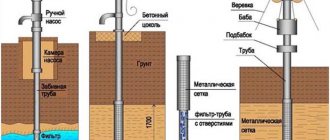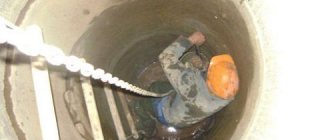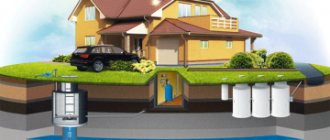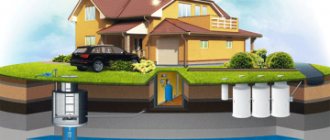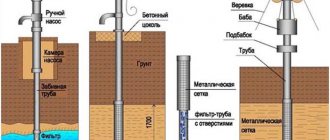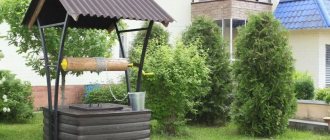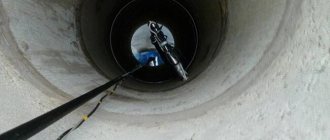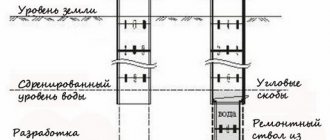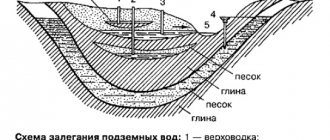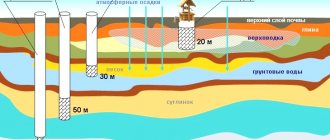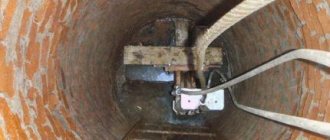The desire to acquire their own source of water for many owners of suburban areas is quite logical and natural. The only stumbling block in resolving this issue is determining what is better - a well or a well?
Builders who provide well-digging services are ready to present a sea of arguments, confirming that the well is an ingenious invention that will serve well for five decades. Masters who specialize in drilling wells convince us that a well is the best option for a hydraulic structure.
Each of these two methods of water extraction has its own pros and cons, and we will consider the main ones in this article. To do this, let’s compare the complexity and cost of constructing each of these water intake options, compare the service life and frequency of preventive cleaning.
We will also talk about the quality and volume of produced water. All these factors will help you decide on the best water extraction method that best suits your living conditions and that can meet all your needs.
Well and borehole: differences in structure and varieties
Individual water supply systems are more difficult to install because they require a direct source of water.
This can be solved in two ways:
- using a well (usual depth 10-15 m);
- using a well (depth of 10-15 m or more).
Wells
The well has been used for many centuries as a source of water, which is located in the permanent aquifer closest to the surface. Its shape is round and its diameter is from 0.5 meters. Rectangular wells are rare. The well passes through the water layer and is buried in a solid layer, which is 0.5-2 m below it.
Manual devices or electric pumps are used to raise water. Water gradually flows down from various horizons and accumulates in the well and is stored there in certain quantities. If you pump out all the water from a well, new water will arrive only after a certain time.
Wells
Wells can be sandy or artesian. A sand well can have a diameter of 3.6 - 5 cm or more. It is shallower than artesian and its filter is installed in a sandy aquifer. At the same time, the depth of the well can reach 20-50 meters. The diameter of an artesian well is from 12 cm, and the depth is 50-100 meters or more.
When using a well, the pump constantly draws water from the wellbore, and new water, passing through the filter, under pressure, continuously re-enters the wellbore. The system works in such a way that the intake of water always compensates for the influx of new water. Therefore, water from a well never runs out, compared to a well.
Now that you know the fundamental differences between a well and a well, we will compare these two sources of water supply to understand in which case one or another source will be better.
Legislation twists
According to the current version of the Law “On Subsoil”, land owners can use groundwater from any horizon. Provided that the daily volume will not exceed 100 m³ and will be used only to meet one’s own needs and not to conduct business. But with one caveat - if this horizon is not a source of centralized water supply and is located above the horizon, which is such a source. And although there is no direct indication, it is understood that we are talking about water intakes from sandy layers. Because to drill an artesian well on limestone, a license is required. And according to the same law, it is not allowed to be issued to private owners who are not individual entrepreneurs.
It turns out that technically today it is possible to drill a well for lime of any depth, if only there was money, such services are provided by a lot of specialized companies, but legally this is illegal. In addition to the fact that no one will give a license to use the subsoil to an individual, almost all deep underground sources are used for centralized water supply. Even if the nearest large populated area is tens of kilometers away, a neighboring SNT or cottage community could very well chip in for a public artesian well. By the way, taking into account all the nuances, today this is the only legal way to organize water supply based on a well for lime. But no license is required for wells and Abyssinian sand wells, which, if properly constructed, will regularly supply the site and house with water for years. Naturally, at your own peril and risk, artesian wells are still drilled all the time, but the danger of getting fined is very real. The authorities have actively taken on unauthorized construction, abandoned buildings and unregistered real estate, where there is a guarantee that they will not begin to tighten the screws regarding water intake.
Choosing a location for a water source
The well must be located at a distance of at least 30 meters from sources of dirt (manure heaps, toilets, cesspools, bathhouses). If a well is installed, the distance can be reduced to 15 meters. It is not recommended to build a well on the slope of a ravine or on the bank of a river, since in this case the main source will be dirty groundwater.
Whatever water extraction system is chosen, it is necessary to ensure the passage and placement of the contractor's equipment and machines, as well as the availability of space for materials on the site. In the case of wells, additional territory is required for disposal of the excavated soil. If a house has not yet been built on the site, you can cut a well directly in the building area. This will significantly reduce the cost of pipelines and caissons, but can become a problem when carrying out well repairs.
Choosing a location for a well can cause more difficulties than choosing a location for a well. When constructing a well, a larger area will be involved than when drilling a well. Especially when you consider the fact that drilling can be carried out with mobile drilling rigs that do not require a large area to operate.
Table
| Well | Well |
| Less deep | Much deeper |
| Worse water quality | The water is cleaner |
| Spacious | Small diameter |
| Water can be collected with a bucket | Pump used (depending on electricity) |
| It is more difficult to ensure sealing | Excellent sealing |
| Water is more susceptible to contamination | No foreign objects get into the water |
| Service is more accessible | More difficult to clean |
| Lower installation costs | Install more expensive |
Water quality
The result of technogenic pollution was the ingress of untreated groundwater into sources at relatively shallow depths. A feature of deeper aquifers is the additional protection of water by clay layers. It is true that in this case, the water content may contain impurities of iron and salt.
Wells, as water intake structures, are designed to collect water from the upper aquifer. And the wells are designed to draw water from underlying horizons, which ensures better quality and greater quantity of water. The purity of water depends on the aquifer in which the well is dug or a well is drilled. In terms of water quality, it is difficult to say whether a well or a well is better, because there is no absolutely clean water in both wells and boreholes.
Thus, when comparing the quality of water in a well or well, the following can be noted: 1. The quality of water in wells has recently decreased significantly, which is due to an increase in the amount of industrial and household waste;
2. In wells, due to greater depth, the water quality is better, but it may contain iron, manganese and hydrogen sulfide.
How often will preventative cleaning be required?
Similar events for the well are held annually. The price of sanitization performed by masters is about 6 thousand rubles.
MBFT-75 Membrane for 75GPD
SF-mix Clack up to 0.8 m3/h
SF-mix Runxin up to 0.8 m3/h
Approximately once every 5 years a major cleaning of siltation is required. It costs another 7 thousand rubles. If it is necessary to change the bottom filter, then the cost doubles.
For a well, all this is a little cheaper. If it is properly equipped, then all care consists only of monitoring its functioning. This hydraulic structure does not require constant monitoring or cleaning.
For it, cleaning is carried out approximately once every 5 years. The service can cost differently - it all depends on its complexity and the depth of the mine. Price limits – 6-50 thousand rubles.
Water is usually purified using special filters. This is necessary regardless of where the moisture is obtained from. The technique varies. Before installation, it is important to understand which type is needed. To understand this and make a decision, you should collect a little liquid from the bottom for analysis. The company ovteh.ru cooperates with a specialized laboratory at Moscow State University at the Department of Soil Science. There they examine what qualities and microelements the source has. Based on this activity, you can determine what filtration will be required. Our specialists will help you select equipment that will trap harmful compounds and heavy metals.
It is easy to control the filter parts - they are simply changed when necessary.
Amount of water
If we consider the productivity of wells and boreholes, we can determine the following. Good flow rates of wells range from 3 to 5 m³ per day. That is, in 24 hours from a well you can pump out from 3000 to 5000 liters. But, in many cases, the maximum amount of fresh water in the wells can be from 1 to 2 m³ per day. In such cases, people are faced with a lack of water, they have to save money, resort to using hydraulic accumulators, rainwater collection tanks, and drip irrigation systems.
The wells are characterized by a more stable flow rate, the indicators of which are:
- from 1 to 3 m³/hour at a depth of up to 50 m;
- from 5 to 6 m³/hour at a depth of 50 to 100 meters.
This means that a well can produce the same amount of water in an hour as a well in a day. However, it should be remembered that high costs require more powerful sewage systems.
To roughly calculate the amount of water required at a specific facility, you should add up all the consumption data. According to SNiP, the amount of water consumed by a person per day is 200 liters. Therefore, the indicated number must be multiplied by the number of residents with a small reserve for guests or in case of small children.
Water consumption standards:
| Object of water consumption | Hand washing | Teeth cleaning | Taking a shower | Taking a bath | Flushing the toilet | Washing cycle in a washing machine | Dishwasher wash cycle |
| Average water consumption, l/day. | 1 — 2 | 1 — 2 | 15 — 30 | 120 — 200 | 5 — 8 | 30 — 60 | 15 — 30 |
| * These data are valid when using modern technology and saving water. | |||||||
To water one cubic meter of soil on a lawn or in a garden you will need from 3 to 6 liters per day. This difference is determined by soil moisture, climatic conditions and the moisture needs of individual plants. Technical expenses should also include car washing and other household needs. Huge volumes of water are required when having a swimming pool. Thus, taking into account household and household needs, the total water consumption per day for a family of four can be from 2 to 4 m3 or even more.
If large water consumption is planned, then the well will clearly not be enough for a full water supply, due to its low flow rate. A well is perfect as an emergency backup or for low water consumption. Thus, when determining whether a well or a borehole is better at a summer cottage or for a house, one should rely on the above factors.
The complexity of the arrangement work
The main difference between a well and a well is the way they are constructed. The well is drilled using specialized equipment. At the moment, there are both large-sized and mobile drilling rigs. Therefore, if you do not have room to maneuver, this will not prevent you from drilling a well. Many well drilling operations are mechanized.
To service the well, a technological pit is installed above its shaft. It can be built of brick or monolithic concrete, has a roof and a hatch. Often the pump itself is installed in the pit.
The well is dug by hand. To do this, special workers are hired to dig a hole approximately two to three meters deep, after which two or three rings are lowered into it. After this, the earth is undermined under them, as a result of which they sink deeper. This happens until the workers reach the required depth.
In terms of the speed of work carried out, the well occupies the leading position. In one day, workers can dig a maximum of three rings in a well. If the soil is dense enough, their number can be reduced to two or even one. That is, a 10-meter well will be dug for at least 5 days. A 10-meter well can be drilled in two hours.
Autonomy of water supply
The operation of the well and borehole is characterized by autonomy. Water from a well can be extracted manually (using a bucket and a special mechanism) or automatically (by installing a pump in the well and running communication pipes to the house).
In the case of a well, for manual water extraction, it is necessary to purchase a special mechanical installation. But as a rule, at present, wells are equipped only with electric pumps.
In the event of a power outage, it will not be possible to draw water from a well, but it can be collected from a well at any time.
Definition
A well is a structure in the form of a collapse-protected recess for extracting underground water.
Well
A well is a drill hole for collecting underground water.
Well
Source durability
The duration of the presence of water in a well or borehole depends on the aquifer from which the water is taken. The durability of sources is unforeseen. It is quite possible that a well will be dug in a neighboring area, hitting the same aquifer, reducing the amount of water in your well or well. Thus, based on this criterion, it is difficult to determine whether a well or a borehole is better for a home.
According to statistics, cases of wells drying up are more common than cases of wells running out of water. The latter are isolated. Most quickly, a well stops functioning as a result of silting or wear of its filter. Wells require maintenance much more often than boreholes.
Preparing to build a well
Laying a well is a rather labor-intensive process that requires competent preparation. A slight error in the distribution and planning of work stages will certainly affect the results.
The preparation of the work includes the main activity - hydrogeological surveys:
- Find out the depth of groundwater during the dry period and during the flow;
- The degree of water withdrawal with minimal precipitation;
- Soil quality: sandy soil type, silt, clay;
- Soil freezing depth.
Suburban areas are located in areas that do not have excessive relief structures; work on constructing a well is carried out in sedimentary deposits. The soil is opened up to the aquifer, bypassing the high water, it is located 2 - 3 meters from the upper layer.
Cost of arrangement
The price for installing a well and a well is not the same. Digging a well is the least expensive option. The cost of work is determined by the depth of the mine, which can range from 3 to 40 meters. The price includes work, delivery and installation of reinforced concrete rings. Additional costs will be spent on communications - pump, pipes, etc.
The price for constructing a well is determined by the geographical location of the site, technical specifications for water supply and the diameter of the well pipe.
If the depth of the aquifer is shallow (10 - 15 meters), then drilling a sand well of small diameter can be cheaper than a well. But most often, drilling a well is a more expensive option.
What is better to choose
Which type to build is up to the owner of the site to decide. We advise you to weigh all the positive and negative sides of each proposal, evaluate which of them will be critical for you personally, and then build on them.
If the owner of the house plans to water only one apple tree every day and use only a barrel of moisture for household needs, then a well shaft is enough for him. If he owns several multi-meter greenhouses, a garden, a vineyard and a large dacha where the family lives permanently, then only a well reservoir can provide such volumes.
Laying communications
To set up an automatic water supply system for your home, you should install a water main and a pump. This process is almost identical for a well and a borehole. The water main consists of an electrical wire, pipe or corrugation, insulation, pipeline and heating cable. In the case of a well, the length of the main line can be several times greater.
The well pump is the central water supply unit in a country house. By rationally choosing a pump for a well, you will ensure its long-term service and comfortable operation. Submersible or surface pumps are used to supply water. To choose the right pump type, you need to know about the water level in the well and its seasonal changes.
When purchasing pumps, it is recommended to pay attention to:
- operational reliability, quality and wear resistance;
- high engine efficiency and energy efficiency;
- the presence of various protective systems;
- the presence of smooth descents;
- small equipment parameters.
In some cases, installing a well pump and supplying communications is a more complex task that is best entrusted to a specialist. Installing a pump in a well is a simpler task; even an amateur can do it.
Well or well: pros and cons, comparative assessment
| Well | Well | |||||||
| Search for water layer | Requires more thorough hydrogeological surveys | Due to the shallower depth, finding water is rarely difficult | ||||||
| Water quality due to the influence of external factors | The water is protected by wide layers of various rocks | Water is located at a critically close distance to polluting industries and farms | ||||||
| Necessity of documentation | No documentation required (except in rare cases at very great depths) | No documentation required | ||||||
| Level of complexity of installation work | The main part of the work is carried out by drilling rigs | Most of the work is done manually, with heavy physical labor | ||||||
| Installation of communication system | Provides for more complex operations | Can be done even by an amateur craftsman | ||||||
| Amount of water | Constant and high debit rates that do not depend on the season | Low debit rates, dependence of the amount of water on the season | ||||||
| Water quality | Higher quality, but may contain impurities | Decreases annually due to an increase in the amount of waste in everyday life and industry | ||||||
| Durability of operation | Works for decades, requires very little maintenance | Lasts for decades and requires frequent cleaning | ||||||
| Price | May exceed the cost of a well due to the relative high cost of drilling | Depends on the depth of the well, usually low and accessible to everyone | ||||||
Which is more productive and autonomous
If this is a key well, then it is considered seasonal. The peak of opportunities occurs in spring and autumn, when there is a lot of rain and warmth, and the snow melts. It dries out in winter and summer.
Mine can be called year-round, given that ice and frost appear regularly in the cold season. You have to insulate the cover and constantly monitor the condition of the pump. When the season changes, when there is high humidity, the quality of the liquid drops sharply. It even leads to the appearance of mud and an unpleasant odor.
The tubular type of well gives the lowest possible debit. Fills slowly, pipe diameter is small. The amount of moisture inside depends on the level of consumption. If you pump out a lot, you will have to wait for filling.
A well shaft is an autonomous reservoir, which always has the required volume for any purpose. It does not become clogged, does not become overgrown with grass, and does not deteriorate. To protect against icing, the upper part of the pipes is covered with thermal insulation. Dispenses a lot of water without running out of water and without having to wait until it is full to use it.
